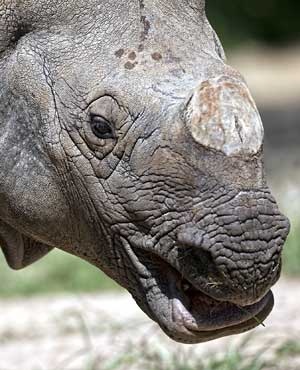US based bio-engineering firm, Pembient, is one of three companies that plans to flood Chinese and Vietnamese markets with synthetic 3D-printed rhino horn in an effort to stem the number of rhinos killed for their horns.
However, conservationists have widely criticised this scheme. “There is general horror at the idea,” says Cathy Dean, international director of the UK-based charity Save the Rhino, which issued a joint statement with the International Rhino Foundation opposing the synthetic horn because of fears that it will “expand the market for such products, complicate law enforcement, and lead to more rhino killings.”
Rhino horn is made up primarily of keratin. Lab-engineered yeast cells can produce the exact same keratins in a similar approach to that being used to create new types of biofuels and medicines. The intention, according to Pembient co-founder and CEO, Matthew Markus, is to then flood Chinese and Vietnamese markets with both 3D-printed synthetic horns and powdered keratin in an attempt to bring down the price which, they hope, will curtail rampant poaching that has already seen rhino deaths in 2015 up 20% from last year’s record figures.
According to market research conducted in Vietnam earlier this year of the 500 people surveyed who used rhino horn for medicinal purposes 45% said they would accept the manufactured artefact instead of real horn.

“But in essence,” says Adam Welz of WildAid, a global organisation that works to reduce consumption by persuading consumers against buying wildlife products, “Pembient is promoting the same myth that the criminal syndicates are peddling – that rhino horn is a product that actually works.”
In this sense, selling synthetic horn could support consumers’ behaviour rather than trying to change it, which could set back ongoing efforts to educate buyers against buying rhino horn. Welz, whose organisation’s rallying cry is ‘when the buying stops the killing can too’ says “marketing artificial horn will undo all the hard work to reduce demand that WildAid have been conducting in China and Vietnam over the past two years”, a campaign that has involved celebrities like Jackie Chan and David Beckham.
Welz also points out that synthetic horn “creates a basis for comparison with the real product. In nearly every case, as has been seen with other wildlife products such as tiger bone, bear bile and ginseng, farmed or artitifical products have created a higher demand for the real product where consumers are prepared to pay more.” Wild populations of tigers, bears and ginseng have all been decimated after farmed products became legal.
Welz highlights that whereas organiSations like WildAid, Save The Rhino and International Rhino Foundation aim to end the demand for rhino horn completely, Pembient want to nourish it. “It is not in their interests to sell products below cost to reduce demand.”
This article was distributed by the Conservation Action Trust and is used with their permission.
FRENCH VERSION
Cependant, défenseurs de l’environnement ont largementcritiqué ce régime. “Il y a horreur général à l’idée,” dit CathyDean, directeur international de l’organisme de bienfaisancebasée au Royaume-Uni Save the Rhino, qui a publié unedéclaration conjointe avec l’International Rhino Foundations’opposant à la corne synthétique en raison des craintes qu’il va“élargir le marché pour ces produits, application des loiscompliquent et plomb aux meurtres de rhino plus.”
Corne de rhinocéros est composé principalement de kératine.Cellules de levure laboratoire d’ingénierie peuvent produire leskératines mêmes exactes dans une approche similaire à celuiutilisé pour créer de nouveaux types de biocarburants et demédicaments. L’intention, selon Pembient co-fondateur et CEO,Matthew Markus, doit ensuite inonder les marchés chinois etvietnamiens avec cornes synthétiques imprimés 3D et en poudrede kératine pour tenter de faire baisser le prix qui, espèrent-ils,va restreindre le braconnage endémique qui a déjà vu des décèsde rhino en 2015, soit 20 % de chiffres record de l’an dernier.
Selon une étude de marché réalisée au Vietnam plus tôt cetteannée des 500 personnes interrogées qui ont utilisé la corne derhinocéros pour fins médicinales 45 % a dit qu’ils accepteraientl’artefact manufacturé au lieu de véritable corne.
“Mais pour l’essentiel”, dit Adam Welz de WildAid, uneorganisation mondiale qui s’emploie à réduire la consommationde persuader les consommateurs contre l’achat de produits de la faune, « Pembient encourage le même mythe que les syndicatscriminels sont colportage – que la corne de rhinocéros est unproduit qui fonctionne réellement. »
En ce sens, corne synthétique de vente pourrait soutenirconsommateurs comportement plutôt que d’essayer de lechanger, qui pourrait remettre des efforts continus visant àsensibiliser les acheteurs contre l’achat de rhino horn. Welz, dontl’organisation du cri de ralliement est “quand l’achat s’arrête lemeurtre peut trop” dit « corne artificielle de commercialisationannulera tous les efforts pour réduire la demande qui WildAidont mené en Chine et au Vietnam au cours des deux dernièresannées », une campagne qui a impliqué des célébrités commeJackie Chan et David Beckham.
Welz a également fait remarquer cette corne synthétique “créeune base de comparaison avec le produit réel. Dans presquetous les cas, on a vu avec d’autres produits animaux sauvagestels que les os de tigre, ours biliaires et ginseng, d’élevage ouproduits d’artitifical ont créé une demande accrue pour leproduit réel où les consommateurs sont prêts à payer plus. » Lespopulations sauvages des tigres, des ours et le ginseng ont tousété décimées après que les produits d’élevage est devenulégales.
Welz met en évidence que, tandis que des organiSations commeWildAid, Save The Rhino et but International Rhino Foundationpour mettre fin à la demande de corne de rhinocéros, Pembientveux nourrir. « Il n’est pas dans leur intérêt de vendre desproduits inférieurs aux coûts pour réduire la demande ».
Cet article a été distribué par l’Action de Conservation Trust etest utilisé avec leur permission


